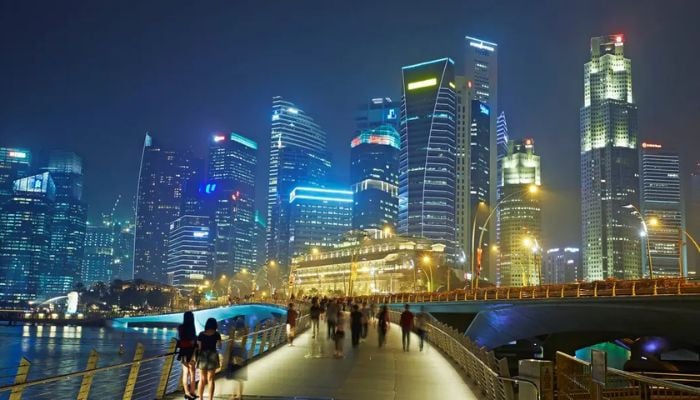Introduction to Singapore’s Blue Zone Status
In August 2023, Singapore was named the world’s sixth Blue Zone, a prestigious designation for regions where people live exceptionally long and healthy lives. Unlike the traditional Blue Zones—Okinawa (Japan), Sardinia (Italy), Nicoya (Costa Rica), Ikaria (Greece), and Loma Linda (California)—Singapore’s longevity is not rooted in centuries-old traditions but in deliberate, forward-thinking policies. This “Blue Zone 2.0” status highlights how urban planning, healthcare, and community-focused initiatives have transformed this Southeast Asian city-state into a global model for longevity and well-being.
What Are Blue Zones?
Defining the Concept
Blue Zones are regions identified by National Geographic journalist Dan Buettner where residents live significantly longer than the global average, often surpassing 100 years. These areas share common traits: plant-based diets, active lifestyles, strong social connections, and low stress. Singapore’s inclusion as a Blue Zone 2.0 marks it as an “engineered” longevity hotspot, driven by policy rather than organic cultural practices.
The Original Five Blue Zones
The original Blue Zones—Okinawa, Sardinia, Nicoya, Ikaria, and Loma Linda—developed longevity naturally through lifestyle and environment. For example, Okinawans practice ikigai (a sense of purpose), while Sardinians benefit from a Mediterranean diet. These regions contrast with Singapore, where government intervention has intentionally shaped a health-conscious society.
Singapore as Blue Zone 2.0
Unlike its predecessors, Singapore’s Blue Zone status stems from modern urban design and proactive governance. Life expectancy has soared from 65 years in 1960 to over 86 years today, with centenarians doubling between 2010 and 2020. This leap reflects policies like universal healthcare and incentives for active living, setting Singapore apart as a model for engineered longevity.
The Pillars of Singapore’s Longevity
World-Class Healthcare System
Singapore’s healthcare system, ranked first globally by the 2023 Legatum Prosperity Index, blends universal coverage with private services and savings funds like Medisave. This ensures accessible, high-quality care while keeping costs manageable. For instance, Khoo Teck Puat Hospital integrates nature into its design to promote healing, reducing stress for patients.
Urban Planning for Active Living
Singapore’s urban design encourages movement. With only 11% car ownership, most residents walk or use public transport, averaging 6,000–8,000 steps daily. Pedestrian-friendly walkways, shaded paths, and extensive public parks like the Singapore Botanic Gardens—a UNESCO World Heritage site—make exercise a natural part of daily life.
Green Spaces and the Garden City
Singapore’s reputation as a “garden city” comes from its integration of nature into urban life. The Urban Redevelopment Authority prioritizes green spaces, with parks and fitness corners accessible to all ages. These spaces foster community and physical activity, key factors in longevity, as seen in the vibrant Singapore Botanic Gardens.
Social Cohesion and Community
Strong social ties are a hallmark of Blue Zones, and Singapore excels here. Policies like the Proximity Housing Grant encourage multigenerational living, keeping families close. Community programs, such as those at public parks, bring together diverse age groups, reducing loneliness and boosting emotional well-being.
Healthy Diet and Food Policies
While traditional Singaporean cuisine includes rich dishes like chili crab, government initiatives promote healthier eating. Programs like Healthy SG encourage balanced diets, and taxes on sugary drinks nudge residents toward better choices. This aligns with Blue Zone principles of plant-based, moderate eating.
How Singapore Engineered Its Blue Zone Status
Government Policies Driving Longevity
Singapore’s government has been intentional in crafting a society that prioritizes health. Policies like taxing cars and gasoline make walking and cycling more practical, while investments in public transport ensure accessibility. These measures, combined with strict laws maintaining cleanliness, create a calm, safe environment conducive to well-being.
The Role of Education
Education is a surprising contributor to Singapore’s longevity. Studies show that quality education, as provided by institutions like Singapore Management University, correlates with better health outcomes. An educated population is more likely to adopt healthy habits, such as regular check-ups and balanced diets, enhancing overall health span.
Innovative Healthcare Delivery
Singapore’s healthcare goes beyond hospitals. Community outreach, like nurses conducting free screenings, ensures preventive care reaches residents. Programs like Healthy SG promote regular health check-ups, catching issues early. This proactive approach reduces the burden of chronic diseases, a major factor in extending health span.
Challenges to Singapore’s Blue Zone Status
The Health Span vs. Lifespan Gap
Despite its achievements, Singapore faces a challenge: the gap between lifespan (84 years) and health span (74 years). This means many residents spend their final decade in poor health, battling chronic conditions like diabetes or heart disease. Addressing this gap is a priority for policymakers aiming for a “Blue Zone 3.0.”
Rising Chronic Diseases
Singaporeans face rising rates of high blood pressure, high cholesterol, and visceral fat, particularly among Asians, who accumulate fat around organs even without obesity. These conditions increase risks of heart disease and diabetes, prompting experts like Dr. Andrea Maier to advocate for better diet and exercise habits.
Mental Health and Stress
Singapore’s fast-paced lifestyle can lead to stress and mental health challenges. In 2022, the city-state saw its highest suicide rates in over 20 years, particularly among youths and the elderly. Loneliness and social isolation remain concerns, highlighting the need for stronger mental health support.
Comparing Singapore to Other Blue Zones
| Blue Zone | Key Longevity Factors | Primary Driver | Life Expectancy |
|---|---|---|---|
| Okinawa, Japan | Ikigai, plant-based diet, social moais | Cultural traditions | ~84 years |
| Sardinia, Italy | Mediterranean diet, active shepherd lifestyle | Genetic isolation, tradition | ~82 years |
| Nicoya, Costa Rica | Plant-based diet, strong family ties | Rural lifestyle | ~81 years |
| Ikaria, Greece | Mediterranean diet, low-stress lifestyle | Island culture | ~83 years |
| Loma Linda, USA | Faith-based community, vegetarian diet | Religious practices | ~81 years |
| Singapore | Urban planning, healthcare, policy-driven health | Government intervention | ~86 years |
Key Differences
Singapore stands out for its engineered approach, relying on policy rather than tradition. While other Blue Zones benefit from rural or isolated settings, Singapore thrives in a dense urban environment. Its focus on infrastructure, like walkable cities and green spaces, contrasts with the organic lifestyles of places like Ikaria or Nicoya.
Shared Traits
Despite differences, Singapore shares core Blue Zone traits: community engagement, active living, and access to healthy food. For example, like Okinawa’s moais, Singapore’s community programs foster social bonds. Its healthcare system mirrors Loma Linda’s emphasis on preventive care, ensuring residents stay healthy longer.
Pros and Cons of Singapore’s Blue Zone Model
Pros
- Accessible Healthcare: Universal coverage and community outreach ensure quality care for all.
- Urban Design: Walkable cities and green spaces promote physical activity.
- Social Policies: Incentives like the Proximity Housing Grant strengthen family ties.
- Clean Environment: Strict laws maintain a safe, stress-free urban setting.
Cons
- High Cost of Living: Singapore’s expensive lifestyle can strain financial resources, especially for retirees.
- Stressful Lifestyle: Urban pace and work culture can lead to mental health challenges.
- Health Span Gap: A decade-long gap between lifespan and health span needs addressing.
- Cultural Disconnect: Unlike traditional Blue Zones, Singapore’s longevity lacks deep cultural roots.
Personal Stories: Living the Blue Zone Life in Singapore
Auntie Mei’s Daily Walks
Auntie Mei, a 78-year-old retiree, starts her day with a walk through Bishan-Ang Mo Kio Park. “The paths are flat, the air is clean, and I meet my friends for tai chi,” she says with a chuckle. “It’s not just exercise—it’s my social time.” Her routine reflects Singapore’s emphasis on accessible green spaces and community, key to her vitality.
Dr. Tan’s Healthcare Mission
Dr. Tan, a physician at Khoo Teck Puat Hospital, sees Singapore’s Blue Zone status firsthand. “We don’t just treat illness; we go to the community with screenings and education,” he explains. His work helping seniors manage diabetes through diet changes showcases how Singapore’s proactive healthcare extends lives.
People Also Ask (PAA)
What Makes Singapore a Blue Zone?
Singapore’s Blue Zone status comes from its engineered approach to longevity, driven by policies like universal healthcare, urban planning for walkability, and community programs. Unlike traditional Blue Zones, its success relies on government intervention rather than cultural traditions.
How Does Singapore’s Healthcare System Support Longevity?
Ranked first globally, Singapore’s healthcare combines universal coverage with private services and savings funds. Community outreach, like free screenings, and facilities like Khoo Teck Puat Hospital, designed with calming natural elements, promote health and reduce chronic disease risks.
Why Is Singapore Called Blue Zone 2.0?
Singapore is dubbed Blue Zone 2.0 because its longevity is intentionally crafted through modern policies, not organic traditions. Initiatives like taxing sugary drinks and promoting multigenerational living create an environment where healthy choices are easier, boosting life expectancy.
Can Other Cities Replicate Singapore’s Blue Zone Model?
Yes, but it requires significant investment in healthcare, urban planning, and social policies. Cities must prioritize walkability, green spaces, and preventive care while fostering community ties. Singapore’s success shows that intentional design can rival traditional Blue Zone outcomes.
Practical Tips for Adopting Singapore’s Blue Zone Habits
For Individuals
- Walk More: Use public transport or walk to nearby destinations to hit 6,000–8,000 steps daily.
- Eat Wisely: Incorporate plant-based meals and limit sugary drinks, following Singapore’s dietary nudges.
- Stay Connected: Join community groups or faith-based activities to build social bonds.
- Prioritize Health Checks: Schedule regular screenings to catch issues early, leveraging Singapore’s preventive care model.
For Policymakers
- Invest in Green Spaces: Create accessible parks and fitness areas to encourage activity.
- Promote Healthy Eating: Implement taxes on unhealthy foods and educate residents on nutrition.
- Foster Community: Develop programs that bring generations together, like Singapore’s Proximity Housing Grant.
- Enhance Healthcare Access: Ensure affordable, high-quality care through universal coverage and outreach.
Wellness Tourism in Singapore
Why Visit Singapore for Longevity?
Singapore’s Blue Zone status makes it a top destination for wellness tourism. Visitors can explore wellness resorts, join lifestyle programs, or visit the Singapore Botanic Gardens for a calming experience. These offerings combine urban sophistication with health-focused activities, appealing to those seeking longevity.
Best Tools for Wellness Travelers
- Wellness Resorts: Resorts like COMO Shambhala offer holistic programs focusing on diet, fitness, and stress management.
- Fitness Apps: Apps like HealthHub provide health tips and track screenings, aligning with Singapore’s preventive care ethos.
- Guided Tours: Book tours through Klook to explore wellness-focused attractions like nature reserves.
- Community Events: Check Eventbrite for local fitness or community activities to join.
The Future of Singapore’s Blue Zone Journey
Aiming for Blue Zone 3.0
Singapore’s leaders, like Health Minister Ong Ye Kung, aim to evolve into a Blue Zone 3.0 by narrowing the health span-lifespan gap. Initiatives like AI-driven health monitoring and sustainable urban development are in the works to ensure residents live not just longer but healthier lives.
Challenges Ahead
Sustaining Blue Zone status requires addressing rising chronic diseases and mental health issues. Singapore must continue innovating, from expanding green spaces to enhancing financial literacy for retirees, to ensure its aging population thrives in both quantity and quality of life.
FAQ
Is Singapore’s Blue Zone Status Scientifically Valid?
While some demographers question Blue Zone accuracy due to record-keeping issues in other regions, Singapore’s status is backed by robust data, including a life expectancy of 86 years and a doubling of centenarians from 2010 to 2020. Its engineered approach adds credibility.
How Can I Live Like a Singaporean for Longevity?
Adopt daily walking, eat a balanced diet with less sugar, stay socially active, and prioritize regular health check-ups. Singapore’s model shows that small, consistent habits, supported by a healthy environment, lead to a longer, better life.
What Role Does Community Play in Singapore’s Longevity?
Community is vital, with policies like the Proximity Housing Grant fostering family ties and public parks hosting group activities. These connections reduce loneliness, a key risk factor for poor health, and enhance emotional well-being.
Are There Downsides to Singapore’s Blue Zone Lifestyle?
Yes, high living costs and a fast-paced urban environment can increase stress and financial strain. Additionally, the 10-year gap between lifespan and health span indicates that chronic illnesses remain a challenge for many residents.
Where Can I Learn More About Blue Zones?
Explore Dan Buettner’s book, The Blue Zones: Secrets for Living Longer, or visit BlueZones.com for insights. For Singapore-specific details, check MOH.gov.sg for health policy updates.
Conclusion
Singapore’s rise as the world’s sixth Blue Zone is a testament to the power of intentional design. Through world-class healthcare, urban planning, and community-focused policies, this city-state has redefined longevity, proving that a modern metropolis can rival the idyllic islands of traditional Blue Zones. Yet, challenges like the health span gap and mental health concerns remind us that the journey to Blue Zone 3.0 is ongoing. For residents and visitors alike, Singapore offers a blueprint for living not just longer but better—blending quantity and quality of life in a way that inspires the world.





